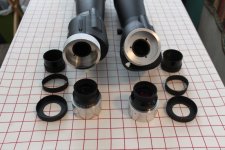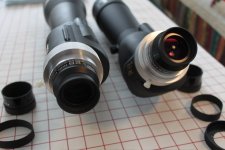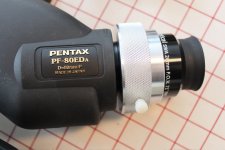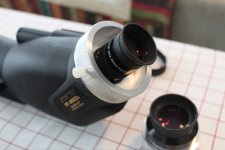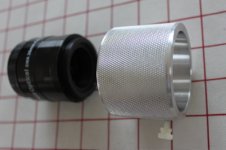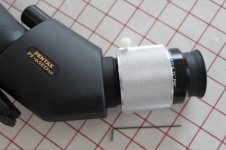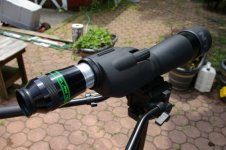Obtaining the widest true field with Pentax spotting scopes
I originally posted about this in the “Cloudy Days & Microscopes” forum of the “Cloudy Nights” astronomy site. When David Rodriguez posted on the Birdforum site about using 100˚ eyepieces in Pentax and other spotting scopes, I posted a link. I just found out that the “Cloudy Days” forum is one of a few NOT viewable unless you are a Cloudy Nights member, so below is the slightly modified post about using 2” eyepieces in the Pentax spotting scopes for those interested on this forum. Apologies to those unable to use the earlier link and thanks to David for suggesting I post it here:
Modifying the Pentax PF Spotting Scopes to Allow Use of a 2” 26 mm Wide Field Eyepiece
I’ve always felt there was a gap between views with hand held binoculars and views with the lowest power commercial spotting scopes that is not satisfied by either. I have enjoyed using telescopes at 16 to 20x with the widest possible field when scanning for birds or other wildlife. That combination, provided by 2” diameter eyepieces in homemade prismatic refractors, allows ideal searching for and viewing small birds and permits watching larger critters like bears at a safe distance. Unfortunately, my homemade scopes are not so compact and ergonomically designed as the Pentax spotters, nor do they have ED glass.
The following is an attempt for a practical “work-around” that permits use of the optics of a 26 mm 2” barrel diameter eyepiece with the Pentax spotting scopes to help fill this gap. For those not familiar with Pentax spotters, they use standard 1.25 inch diameter eyepieces and the 100 mm and 80 mm objective diameter ones have an unusual thin ring collar about 2.5” in diameter around the eyepiece holder that serves as a grip to tighten their 1.25” eyepiece-holding collet. The ring is shaped like a shallow cup, is flat bottomed, and secured to the eyepiece collet body with three small screws. In standard use, a 1.25” eyepiece is inserted into the scope in the center of this ring and turning the ring clockwise tightens the collet to secure the 1.25” barrel of the eyepiece in the spotting scope. The focal plane of the spotter is about level with the bottom of the cup shaped ring. To allow a 2” eyepiece to focus this image for an observer, the bottom 2” barrel extension must be removed from the eyepiece and just the upper part of the eyepiece (containing all the optics) held so that the image comes into focus. Since the maximum size of the image is still limited by the 1.25 inch opening, only 2 inch eyepieces with a 1.25” (or 31.75 mm) field stop can be used without “barrel limited” vignetting. Because there is no 1.25 inch barrel protruding into the collet opening, this configuration allows an incrementally larger true field than is possible with any 1.25 inch diameter eyepiece. The 26 mm focal length 71˚ apparent field of view (Afov) Super Wide Angle (SWA) eyepiece was selected because it comes closest to meeting these constraints.
To hold the optics of a 2” barrel diameter eyepiece in the spotter, I used a lathe to machine a modified replacement for the collet tightening ring collar from 3” aluminum stock. The new part duplicates the same size central bottom hole, the same bottom thickness (.060”) and the same top ID (2.5”) but with a quarter inch thick outer rim. The total OD of the new part is therefore 3”. The height of the new part is about .8” rather than the .5” of the original, so as to better hold the upper part of a 2” eyepiece. Duplicating the three screw holes in the new ring enables the same three screws to attach the new ring to the eyepiece collet body of the scope. The original part is fluted for grip, but it was easier to knurl the outer rim on the replacement part. This thicker rim is tapped radially 6-32 to allow a nylon thumbscrew to be used to hold the larger diameter eyepiece, secured in a 2.5” OD turned aluminum adapter. See photo 1 for modified scopes without eyepiece inserted.
A simple bushing adapter bringing a Garrett 26 mm FL 71 degree Afov SWA eyepiece OD to just under 2.5” enables use of that eyepiece with no noticeable vignetting when used visually. The bushing is held to the eyepiece body by a single 4-40 set screw. The lower 2” barrel originally on the Garrett eyepiece, needed for use in a 2” focuser, is simply unscrewed and set aside. The rubber grip ring of the eyepiece comes off easily and will cover the set screw mark from the adapter if the eyepiece is returned to its original 2” barrel configuration. The resulting 20x with a 3.5 degree true field is the best low power wide field view I’ve been able to attain with the 80 mm 518 mm FL angled Pentax scope. For comparison, a 20 mm XW gives 26x @ 2.7 degrees, a 24 Pan gives 22x @ 3.2 degrees, and the discontinued Pentax XL 28 mm gives 18.5x @ 3.0 degrees. The SWA eyepiece is also very “user friendly” for folks unfamiliar with telescopes– and eliminates worry about damage to your premium eyepieces by inexperienced viewers. See photos 2 & 3 for views of modified scopes with the 2” 26 mm SWA eyepiece in place.
The PF-100ED scope has an identical collet grip ring, so I made two of the modified replacement rings. In bigger scope, the 26 mm SWA gives 24x and a 2.9 degree field – a similar wide field improvement over the views provided when using 1.25” diameter oculars in this scope.
The scopes are still usable with 1.25” eyepieces for higher magnification with the new rings installed. See photo 4 for a view of the modified PF-80EDA with a 1.25” barrel diameter 20 mm FL SWA eyepiece installed. Because no modifications are made to the Pentax scope parts, the spotting scope can be restored to original by just taking off the new ring and re-attaching the removed Pentax collet-tightening ring with the same 3 screws.
2” 26 mm SWA eyepiece for the Pentax PF-65EDA scope
The smallest of the Pentax spotting scopes that use 1.25” eyepieces is the PF-65EDAII. While mine is the angled version, I believe the following would apply to the straight through version (PF-65EDII), too. Unlike the two larger Pentax PF spotting scopes, the PF-65 does not have the unique upturned-cup-shaped collet-tightening ring. Instead, the housing around the eyepiece is flat on top. The three familiar screws around the 1.25” eyepiece collet are still used, but on this model the screws hold a smaller cup that is attached inverted from the direction of the other two models. In other words, it is attached so that its rim is towards the scope body. On this small scope, large top-diameter eyepieces like the Pentax XW simply overhang the edges of that smaller diameter ring. While at first disappointed that the same modifications used with the larger Pentax spotters would not work, I soon realized that this scope’s collet-tightening arrangement is actually easier to adapt to the 2” eyepiece than the others. For this one, NO modification to the scope itself is needed. Once again, the lower 2” barrel of the 2” 26 mm FL SWA eyepiece is removed and set aside and a simple 2.5” OD aluminum tube, 1.75” long with .25” thick wall, is bored at the top to hold the eyepiece body. On this smaller Pentax scope, the eyepiece is held recessed above the bottom of the adapter so the adapter will fit OVER the outside of the collet-tightening ring. Once again, a tiny (4-40) steel set screw through the upper barrel secures the adapter to the eyepiece. The set screw hits the eyepiece body in the area normally covered by the rubber grip ring. The rubber ring is easily removed. (Thus the eyepiece can be restored to 2” usefulness with no visible blemish.) The larger ID lower section of the aluminum tube is bored for an easy fit over the collet-tightening ring, and drilled and tapped 6-32 radially. Once the eyepiece is put in place, a 6-32 nylon thumbscrew secures it to the scope without marking the outside of the ring. In the prototype, the outside of the adapter barrel was knurled for better grip, but that is unnecessary to its function. See photo 5 below and photo 6 in the next post of this thread.
The field stop of the 26 SWA eyepiece is less than half a millimeter larger than the 1.25” scope eyepiece opening, so rather than the 71 degree apparent field rated for the Garrett SWA, on the Pentax PF scopes it is limited to about 70 degrees. The Pentax PF-65EDA-II has a focal length of 390 mm, so the 26 mm SWA eyepiece gives magnification of 15x and a true field of 4.6 degrees. In more common spotting scope field specification, that’s 244 feet at 1000 yards. For my usage, this adequately fills in the gap between handheld binoculars and the lowest power, widest field formerly available with the 65 mm spotter, about 19.5x with 3.6 degree true field with the Pentax 20XW eyepiece.
Though only incremental improvement, gaining 1˚ of extra true field over the 20 XW makes the scope much easier to use when following moving birds or critters. The GSO made 26 mm SWA eyepiece, whether branded Garrett (better anodizing), Agena (free bolt case and shipping), or Orion Q70; provides an economical ($70 new from Garrett) “widest field possible” eyepiece for the three Pentax spotters designed for 1.25” eyepieces. The views provided are sharp nearly to the edge of the field. (The Pentax 20 XW is sharper, but much more expensive and true field is not so wide.) The SWA eyepiece field also shows less pincushion distortion than the 68 degree Afov. 24 mm Panoptic, which is optimized to yield an excellent, sharp field for astronomical use. Despite its name, I find the 24 Pan objectionable when “panning” a scope across terrestrial views because of that distortion. With no straight lines to “bend” at the edge of the field, the 24 Pan is great for astronomical use.
If the 26 mm SWA eyepiece bushing adapter (for the PF65ED) and the knurled replacement collet rings (for the PF80 and PF100) are attached so that the nylon securing thumbscrew is oriented upward, the protective Pentax nylon case furnished with each scope will still fit and zip closed, protecting the scope with the big eyepiece in place. For those with access to a metal lathe, making the adapters described allow use of the 26 mm SWA eyepiece with Pentax PF65, PF80 and PF100 spotting scopes to give maximum true field for each. All these scopes with the adapted 26 mm SWA eyepiece will focus at infinity. Very myopic folks may need to take a little metal off the bottom of the eyepiece body to allow the extra “in” focus they need if they wish to use this eyepiece in the Pentax scopes without their glasses. The field lens holding retaining ring in the 26 SWA eyepiece is threaded for a full .5 inches, so plenty of adjustment is possible. I did these modifications to my Pentax spotting scopes in the spring of 2011 and used them extensively during the summer. I found that this added wide field capability is very useful for wildlife viewing and now leave the big 26 mm SWA eyepieces on each of my scopes, changing to higher power with shorter focal length eyepieces only when more magnified detail is needed. - Bill
I originally posted about this in the “Cloudy Days & Microscopes” forum of the “Cloudy Nights” astronomy site. When David Rodriguez posted on the Birdforum site about using 100˚ eyepieces in Pentax and other spotting scopes, I posted a link. I just found out that the “Cloudy Days” forum is one of a few NOT viewable unless you are a Cloudy Nights member, so below is the slightly modified post about using 2” eyepieces in the Pentax spotting scopes for those interested on this forum. Apologies to those unable to use the earlier link and thanks to David for suggesting I post it here:
Modifying the Pentax PF Spotting Scopes to Allow Use of a 2” 26 mm Wide Field Eyepiece
I’ve always felt there was a gap between views with hand held binoculars and views with the lowest power commercial spotting scopes that is not satisfied by either. I have enjoyed using telescopes at 16 to 20x with the widest possible field when scanning for birds or other wildlife. That combination, provided by 2” diameter eyepieces in homemade prismatic refractors, allows ideal searching for and viewing small birds and permits watching larger critters like bears at a safe distance. Unfortunately, my homemade scopes are not so compact and ergonomically designed as the Pentax spotters, nor do they have ED glass.
The following is an attempt for a practical “work-around” that permits use of the optics of a 26 mm 2” barrel diameter eyepiece with the Pentax spotting scopes to help fill this gap. For those not familiar with Pentax spotters, they use standard 1.25 inch diameter eyepieces and the 100 mm and 80 mm objective diameter ones have an unusual thin ring collar about 2.5” in diameter around the eyepiece holder that serves as a grip to tighten their 1.25” eyepiece-holding collet. The ring is shaped like a shallow cup, is flat bottomed, and secured to the eyepiece collet body with three small screws. In standard use, a 1.25” eyepiece is inserted into the scope in the center of this ring and turning the ring clockwise tightens the collet to secure the 1.25” barrel of the eyepiece in the spotting scope. The focal plane of the spotter is about level with the bottom of the cup shaped ring. To allow a 2” eyepiece to focus this image for an observer, the bottom 2” barrel extension must be removed from the eyepiece and just the upper part of the eyepiece (containing all the optics) held so that the image comes into focus. Since the maximum size of the image is still limited by the 1.25 inch opening, only 2 inch eyepieces with a 1.25” (or 31.75 mm) field stop can be used without “barrel limited” vignetting. Because there is no 1.25 inch barrel protruding into the collet opening, this configuration allows an incrementally larger true field than is possible with any 1.25 inch diameter eyepiece. The 26 mm focal length 71˚ apparent field of view (Afov) Super Wide Angle (SWA) eyepiece was selected because it comes closest to meeting these constraints.
To hold the optics of a 2” barrel diameter eyepiece in the spotter, I used a lathe to machine a modified replacement for the collet tightening ring collar from 3” aluminum stock. The new part duplicates the same size central bottom hole, the same bottom thickness (.060”) and the same top ID (2.5”) but with a quarter inch thick outer rim. The total OD of the new part is therefore 3”. The height of the new part is about .8” rather than the .5” of the original, so as to better hold the upper part of a 2” eyepiece. Duplicating the three screw holes in the new ring enables the same three screws to attach the new ring to the eyepiece collet body of the scope. The original part is fluted for grip, but it was easier to knurl the outer rim on the replacement part. This thicker rim is tapped radially 6-32 to allow a nylon thumbscrew to be used to hold the larger diameter eyepiece, secured in a 2.5” OD turned aluminum adapter. See photo 1 for modified scopes without eyepiece inserted.
A simple bushing adapter bringing a Garrett 26 mm FL 71 degree Afov SWA eyepiece OD to just under 2.5” enables use of that eyepiece with no noticeable vignetting when used visually. The bushing is held to the eyepiece body by a single 4-40 set screw. The lower 2” barrel originally on the Garrett eyepiece, needed for use in a 2” focuser, is simply unscrewed and set aside. The rubber grip ring of the eyepiece comes off easily and will cover the set screw mark from the adapter if the eyepiece is returned to its original 2” barrel configuration. The resulting 20x with a 3.5 degree true field is the best low power wide field view I’ve been able to attain with the 80 mm 518 mm FL angled Pentax scope. For comparison, a 20 mm XW gives 26x @ 2.7 degrees, a 24 Pan gives 22x @ 3.2 degrees, and the discontinued Pentax XL 28 mm gives 18.5x @ 3.0 degrees. The SWA eyepiece is also very “user friendly” for folks unfamiliar with telescopes– and eliminates worry about damage to your premium eyepieces by inexperienced viewers. See photos 2 & 3 for views of modified scopes with the 2” 26 mm SWA eyepiece in place.
The PF-100ED scope has an identical collet grip ring, so I made two of the modified replacement rings. In bigger scope, the 26 mm SWA gives 24x and a 2.9 degree field – a similar wide field improvement over the views provided when using 1.25” diameter oculars in this scope.
The scopes are still usable with 1.25” eyepieces for higher magnification with the new rings installed. See photo 4 for a view of the modified PF-80EDA with a 1.25” barrel diameter 20 mm FL SWA eyepiece installed. Because no modifications are made to the Pentax scope parts, the spotting scope can be restored to original by just taking off the new ring and re-attaching the removed Pentax collet-tightening ring with the same 3 screws.
2” 26 mm SWA eyepiece for the Pentax PF-65EDA scope
The smallest of the Pentax spotting scopes that use 1.25” eyepieces is the PF-65EDAII. While mine is the angled version, I believe the following would apply to the straight through version (PF-65EDII), too. Unlike the two larger Pentax PF spotting scopes, the PF-65 does not have the unique upturned-cup-shaped collet-tightening ring. Instead, the housing around the eyepiece is flat on top. The three familiar screws around the 1.25” eyepiece collet are still used, but on this model the screws hold a smaller cup that is attached inverted from the direction of the other two models. In other words, it is attached so that its rim is towards the scope body. On this small scope, large top-diameter eyepieces like the Pentax XW simply overhang the edges of that smaller diameter ring. While at first disappointed that the same modifications used with the larger Pentax spotters would not work, I soon realized that this scope’s collet-tightening arrangement is actually easier to adapt to the 2” eyepiece than the others. For this one, NO modification to the scope itself is needed. Once again, the lower 2” barrel of the 2” 26 mm FL SWA eyepiece is removed and set aside and a simple 2.5” OD aluminum tube, 1.75” long with .25” thick wall, is bored at the top to hold the eyepiece body. On this smaller Pentax scope, the eyepiece is held recessed above the bottom of the adapter so the adapter will fit OVER the outside of the collet-tightening ring. Once again, a tiny (4-40) steel set screw through the upper barrel secures the adapter to the eyepiece. The set screw hits the eyepiece body in the area normally covered by the rubber grip ring. The rubber ring is easily removed. (Thus the eyepiece can be restored to 2” usefulness with no visible blemish.) The larger ID lower section of the aluminum tube is bored for an easy fit over the collet-tightening ring, and drilled and tapped 6-32 radially. Once the eyepiece is put in place, a 6-32 nylon thumbscrew secures it to the scope without marking the outside of the ring. In the prototype, the outside of the adapter barrel was knurled for better grip, but that is unnecessary to its function. See photo 5 below and photo 6 in the next post of this thread.
The field stop of the 26 SWA eyepiece is less than half a millimeter larger than the 1.25” scope eyepiece opening, so rather than the 71 degree apparent field rated for the Garrett SWA, on the Pentax PF scopes it is limited to about 70 degrees. The Pentax PF-65EDA-II has a focal length of 390 mm, so the 26 mm SWA eyepiece gives magnification of 15x and a true field of 4.6 degrees. In more common spotting scope field specification, that’s 244 feet at 1000 yards. For my usage, this adequately fills in the gap between handheld binoculars and the lowest power, widest field formerly available with the 65 mm spotter, about 19.5x with 3.6 degree true field with the Pentax 20XW eyepiece.
Though only incremental improvement, gaining 1˚ of extra true field over the 20 XW makes the scope much easier to use when following moving birds or critters. The GSO made 26 mm SWA eyepiece, whether branded Garrett (better anodizing), Agena (free bolt case and shipping), or Orion Q70; provides an economical ($70 new from Garrett) “widest field possible” eyepiece for the three Pentax spotters designed for 1.25” eyepieces. The views provided are sharp nearly to the edge of the field. (The Pentax 20 XW is sharper, but much more expensive and true field is not so wide.) The SWA eyepiece field also shows less pincushion distortion than the 68 degree Afov. 24 mm Panoptic, which is optimized to yield an excellent, sharp field for astronomical use. Despite its name, I find the 24 Pan objectionable when “panning” a scope across terrestrial views because of that distortion. With no straight lines to “bend” at the edge of the field, the 24 Pan is great for astronomical use.
If the 26 mm SWA eyepiece bushing adapter (for the PF65ED) and the knurled replacement collet rings (for the PF80 and PF100) are attached so that the nylon securing thumbscrew is oriented upward, the protective Pentax nylon case furnished with each scope will still fit and zip closed, protecting the scope with the big eyepiece in place. For those with access to a metal lathe, making the adapters described allow use of the 26 mm SWA eyepiece with Pentax PF65, PF80 and PF100 spotting scopes to give maximum true field for each. All these scopes with the adapted 26 mm SWA eyepiece will focus at infinity. Very myopic folks may need to take a little metal off the bottom of the eyepiece body to allow the extra “in” focus they need if they wish to use this eyepiece in the Pentax scopes without their glasses. The field lens holding retaining ring in the 26 SWA eyepiece is threaded for a full .5 inches, so plenty of adjustment is possible. I did these modifications to my Pentax spotting scopes in the spring of 2011 and used them extensively during the summer. I found that this added wide field capability is very useful for wildlife viewing and now leave the big 26 mm SWA eyepieces on each of my scopes, changing to higher power with shorter focal length eyepieces only when more magnified detail is needed. - Bill




